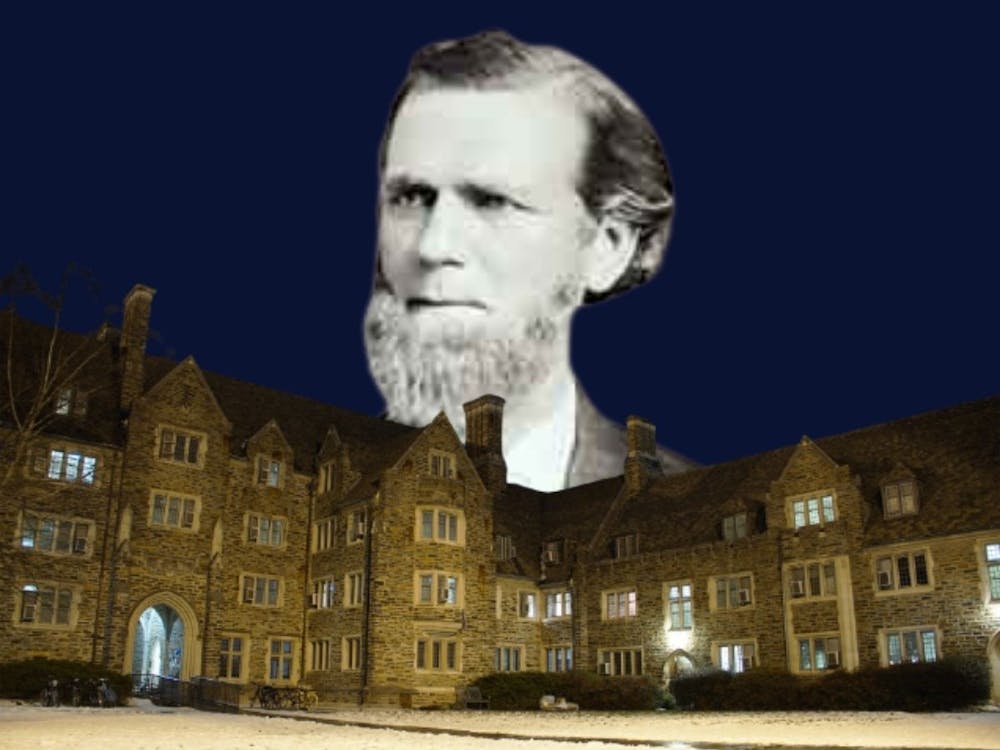West Campus' Craven Quad is named for Braxton Craven, a president of Duke's predecessor Trinity College—and a slaveowner and supporter of the Confederacy.
Craven was the president of Trinity College, the institution that eventually became Duke, from 1842 to 1863 and 1866 to 1882, making him the institution’s longest-serving president to date. University Archivist Valerie Gillispie said Craven’s name was not chosen for the quad for a specific reason, except that all the dorms on West Campus were named for former presidents.
Craven owned at least three enslaved people by 1860, according to that year’s Slave Schedule, taken as part of the U.S. Census: a 48-year-old man, a 38-year-old woman and a 20-year-old woman.
Craven intended to purchase more enslaved children, but was deterred by the cost. He wrote in 1858 that they “brought larger prices than [he] was willing to give,” according to a report by the Construction of Memory at Duke and in Durham Bass Connections team.
Craven was raised in a family of abolitionists, and many residents of Randolph County, where Trinity College was located, opposed slavery, according to Thought his family were Quakers, Craven later converted, becoming a Methodist, and his newfound faith also condemned slavery.
According to former Duke professor John Spencer Bassett in the report, Activating History for Justice at Duke, “‘The spirit of the [Methodist] church was undoubtedly against’ the holding of slaves by ministers.”
Craven was only able to own enslaved people because of “a loophole allowing ministers to own slaves in states that required freed slaves to leave the state, a requirement throughout the South,” according to the report.
Craven also supported the Confederacy. Though initially opposed to the Civil War, in 1860 Craven wrote to a colleague that “if the North will improve the Fugitive Slave Law, crush their personal liberty laws… we would do far better to stay in the Union”, according to the Activating History report.
The report explains that during the Civil War, Craven created the Trinity Home Guard as a way for students to avoid leaving college to fight in the war. The Home Guard’s “job was to capture deserters and escaped slaves, punish dissenters and seize supplies for the army.” Craven also arranged for students to serve as guards at a prison for captured Union soldiers.
When Craven served as president, his leadership led Trinity to becoming well known throughout the region, enrolling students from all across the southern United States, according to an archived Duke Libraries website.
Craven was also a respected scholar, teaching “Ancient Languages, Mental and Moral Science, Metaphysics, Rhetoric and Logic, National and Constitutional Law, and Biblical Literature,” according to the website.
Duke has a process in place to grapple with the complicated legacies of those whose names appear prominently on campus. In 2017, following the defacement and subsequent removal of a statue of Robert E. Lee from the Duke Chapel, President Vincent Price announced the creation of the Commission on Memory and History. The committee was reformed and renamed last year as the President’s Advisory Committee on Institutional History.
The Committee has been “charged with developing principles to apply when issues arise related to the names of university facilities and monuments on campus,” according to the message initially sent to students by Price.
Gillispie, who is on the advisory committee, added that the Board of Trustees, not the committee, has the authority to remove or rename buildings.
The procedures implemented by the Commission were used following a recommendation made in 2018 by the Department of History to rename the former Carr Building on East Campus. The building bore the name of Julian Carr, a donor who was also a “member of the initial Ku Klux Klan and ran unsuccessfully for the U.S. Senate in 1900 on a white supremacist platform.”
The Board of Trustees voted to rename the Carr Building following a recommendation by Price and a subcommittee formed by the Commission. It now bears its original name, the Classroom Building.
“As far as I know, there has not been a formal request to rename Craven as of yet,” Gillispie said.
Get The Chronicle straight to your inbox
Signup for our weekly newsletter. Cancel at any time.
Anisha Reddy is a Trinity junior and a senior editor of The Chronicle's 118th volume.

